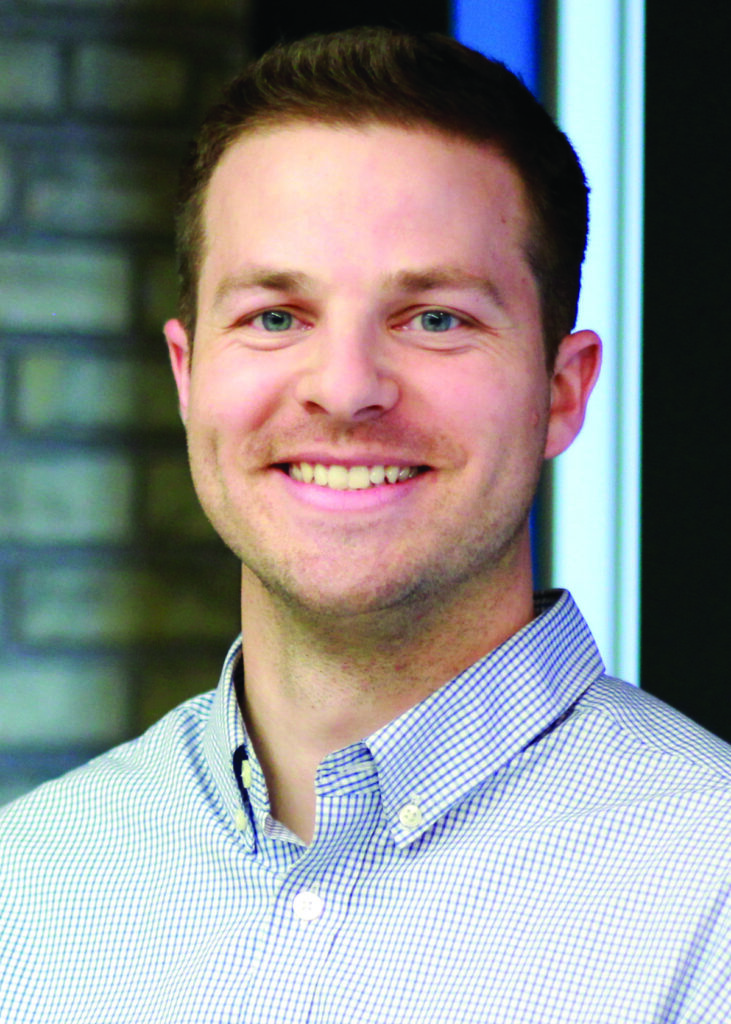
Architect Rob Remark
Planned community center will bring Moorheaders together
Nancy Edmonds Hanson
What will the new community center mean for Moorhead? It’s an open question – and that’s a good thing.
When Mayor Shelly Carlson appointed a task force to study the possibilities of combined regional library and community center, the group turned to Moorhead residents to define some of what they’d like to see in the new facility. What they have come up with, says architect Rob Remark – who is working with the task force as a volunteer – is, in his words, “a community living room.”
“People do have an idea of what a library is,” he suggests. “They think of books. Today’s libraries are much, much more than that, but at least they have something in mind.”
The community center side of the proposed downtown facility, though, is a more open question. Is it an indoor playground for children? A place where individuals and families can meet and greet? A walking track where they can exercise year round regardless of the weather? Meeting rooms for education and socializing?
The architect, who is Moorhead born and raised, envisions something that is all that, and more: “It’s going to be the community’s living room.”
Moorhead residents will vote Nov. 8 on enacting a half-cent city sales tax that will fund construction of the center, pegged at $31 million. The concept was unveiled earlier this fall. The 50,000-sq.-ft. Structure will occupy the southwest corner of the Center Mall parking lot, an anchor of the whole area where redevelopment is slated over the next few years – a citywide gathering space among what are envisioned as stores, restaurants and hundreds of apartments and condominiums intended to create a vibrant community embracing the Red River in the heart of the city.
Remark and his firm, JLG Architects, stepped up early with an offer to provide early planning assistance to the task force. They are providing their services pro bono – at no charge – to help the concept take shape before city residents’ eyes.
The components of the center are still in the vision stage. They have come, he says, from the public listening sessions that took place last April – two public meetings where the task force asked residents to outline what they’d like to see in the center.
“They gave us plenty of input,” Remark says. Among the most popular suggestions reflected in the “word cloud” developed after the event: Meeting and hangout spots for all ages. A walking track and play areas for year-round use. Windows, natural light and a green space (possibly connecting to the outdoors and leading to the river). Collaborative coworker and “maker” spaces for hands-on learning. A place for public art and cultural programming. A coffee house or cafe for relaxing and keeping an eye on the kids.
And, of course, the new library itself. “Libraries are completely different than the image of dusty shelves of books that some people may picture if they haven’t been there in awhile,” Remark emphasizes. “They are places for personal development. They offer hands-on activities for all ages. They’re centers of technology – with computers and internet access for everything from applying for jobs to online learning. They’re coworking spaces, learning spaces, community spaces that bring people with different interests together.”
By combining the library and community center, the new facility will accommodate all kinds of interests and groups. Librarian Megan Krueger points out that the present library’s meeting rooms (the largest of which holds only 50 people) are in high demand at all hours and days of the week. Among the groups who meet there regularly are the local coin and model railroad clubs, the Clay County Bar Association, local businesses that use the free spaces for staff training, knitting and quilting groups, several Girl Scout troops, both the Democrats and Republicans of Clay County, the Audubon Society, breast cancer survivors, and organizations as disparate as therapy dogs and writers.
The need for a new library building, of course, is critical. On Oct. 10 the library was closed for staff training. Among the topics was active shooter training. A loud explosion shook the room, sending staffers diving under the tables. According to librarian Megan Krueger, the air handler in the aged HVAC system exploded, blowing out transformers and killing the power to the entire block. When repair crews and electricians were at work earlier this week, they found wiring conduits full of melted electrical wires, causing the library to be shut down completely on Tuesday.
Thus far, the community center and regional library is entirely in the concept stage; no design work has been begun, since the sales tax – with 30% of its revenue coming from outside the city – is the sole source of funding to start the project. Concrete design work can be begun with the measure’s passage in November.
In the meantime, Remark says, the possibilities are exciting.
“We see a building that can be opened up for larger events and subdivided for smaller ones,” he suggests. “We envision higher ceilings and a bigger volume of space … a flexible, comfortable space to accommodate all kinds of different functions and seasonal activities. It will be active, not static.”
He emphasizes that the November vote, which was approved by the Minnesota Legislature early this year, is not concerned with the design of the building. That’s yet to come.
“This is a vote on the idea of supporting and growing Moorhead,” he says. “It’s going to be a catalyst for everything that’s coming up downtown. It will be the community’s living room … a project to bring together and support the entire community.”
For more information about the community center/regional library project and the upcoming vote, go online to www.yes56560.com.


